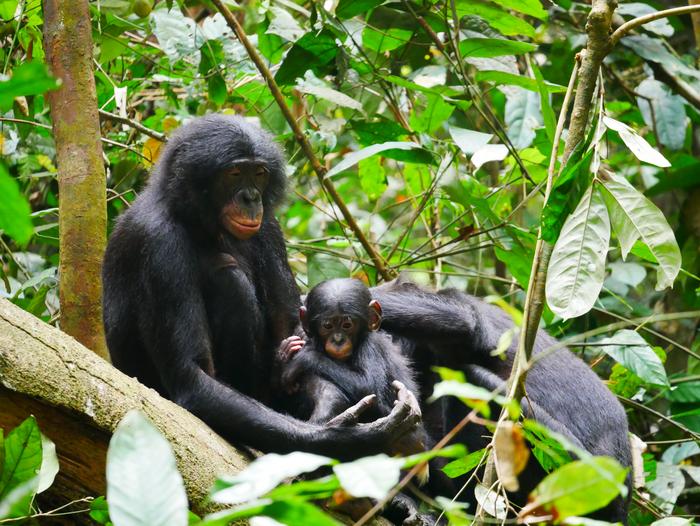Chimpanzees and bonobos are often thought to reflect two different sides of human nature—the conflict-ready chimpanzee versus the peaceful bonobo—but a new study publishing April 12 in the journal Current Biology shows that, within their own communities, male bonobos are more frequently aggressive than male chimpanzees. For both species, more aggressive males had more mating opportunities.

Credit: Maud Mouginot
Chimpanzees and bonobos are often thought to reflect two different sides of human nature—the conflict-ready chimpanzee versus the peaceful bonobo—but a new study publishing April 12 in the journal Current Biology shows that, within their own communities, male bonobos are more frequently aggressive than male chimpanzees. For both species, more aggressive males had more mating opportunities.
“Chimpanzees and bonobos use aggression in different ways for specific reasons,” says anthropologist and lead author Maud Mouginot of Boston University. “The idea is not to invalidate the image of bonobos being peaceful—the idea is that there is a lot more complexity in both species.”
Though previous studies have investigated aggression in bonobos and chimpanzees, this is the first study to directly compare the species’ behavior using the same field methods. The researchers focused on male aggression, which is often tied to reproduction, but they note that female bonobos and chimpanzees are not passive, and their aggression warrants its own future research.
To compare bonobo and chimpanzee aggression, the team scrutinized rates of male aggression in three bonobo communities at the Kokolopori Bonobo Reserve (Democratic Republic of Congo) and two chimpanzee communities at Gombe National Park (Tanzania). Overall, they examined the behavior of 12 bonobos and 14 chimpanzees by conducting “focal follows,” which involved tracking one individual’s behavior for an entire day and taking note of how often they engaged in aggressive interactions, who these interactions were with, and whether they were physical or not (e.g., whether the aggressor engaged in pushing and biting or simply chased their adversary).
“You go to their nests and wait for them to wake up and then you just follow them the entire day— from the moment they wake up to the moment they go to sleep at night—and record everything they do,” says Mouginot.
To their surprise, the researchers found that male bonobos were more frequently aggressive than chimpanzees. Overall, bonobos engaged in 2.8 times more aggressive interactions and 3 times as many physical aggressions.
While male bonobos were almost exclusively aggressive toward other males, chimpanzees were more likely to act aggressively toward females. Chimpanzee aggression was also more likely to involve “coalitions” of males (13.2% vs. 1% of bonobo aggressions). The researchers think that these coalitions might be one reason why aggression is less frequent among chimpanzees. Altercations involving groups of males have the potential to cause more injuries, and within-community fighting could also weaken the group’s ability to fight off other groups of chimpanzees. Bonobos don’t have this issue because most of their disputes are one on one, they have never been observed to kill one another, and they are not thought to be territorial, which leaves their communities free to bicker among themselves.
For both chimpanzees and bonobos, more aggressive males had greater mating success. The researchers were surprised to find this in bonobos, which have a co-dominant social dynamic in which females often outrank males, compared to chimpanzees, which have male-dominated hierarchies in which male coalitions coerce females into mating.
“Male bonobos that are more aggressive obtain more copulations with females, which is something that we would not expect,” said Mouginot. “It means that females do not necessarily go for nicer males.”
These findings partially contradict a prevailing hypothesis in primate and anthropological behavior—the self-domesticating hypothesis—which posits that aggression has been selected against in bonobos and humans but not chimpanzees.
The researchers were not able to assess the severity of aggressive interactions in terms of whether they resulted in wounds or injuries, but this is data that they hope to collect in future. They also want to compare aggressive behavior in other groups of chimpanzees and bonobos as it’s possible that behavior varies between communities and subspecies.
“I’d love to have the study complemented with comparable data from other field sites so we can get a broader understanding of variation within and between species,” says Mouginot.
###
This research was supported by Harvard University, Duke University, Franklin and Marshall College, George Washington University, the University of Minnesota, the Max Planck Society, the Institute for Advanced Study Toulouse, the Leakey Foundation, the National Institutes of Health, the National Science Foundation, the Arcus Foundation, Carnegie Corporation, the Leo S. Guthman Foundation, Margo Marsh, Mazuri, the Morris Animal Foundation, the National Geographic Society, the Harris Steel Group, the Waitt Foundation, the William T. Grant Q12 Foundation, the Windibrow Foundation, and the Jane Goodall Institute.
Current Biology, Mouginot et al., “Differences in expression of male aggression between wild bonobos and chimpanzees” https://www.cell.com/current-biology/fulltext/S0960-9822(24)00253-7
Current Biology (@CurrentBiology), published by Cell Press, is a bimonthly journal that features papers across all areas of biology. Current Biology strives to foster communication across fields of biology, both by publishing important findings of general interest and through highly accessible front matter for non-specialists. Visit http://www.cell.com/current-biology. To receive Cell Press media alerts, contact [email protected].
Journal
Current Biology
DOI
10.1016/j.cub.2024.02.071
Method of Research
Observational study
Subject of Research
Animals
Article Title
Differences in expression of male aggression between wild bonobos and chimpanzees
Article Publication Date
12-Apr-2024




